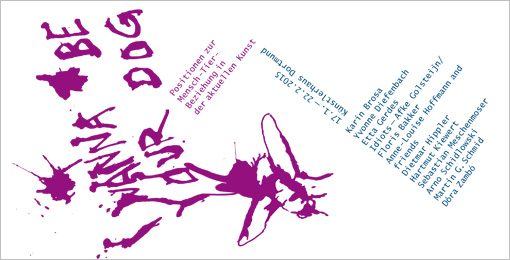
The cultural concept of society regarding the animal assumes the human dominance. The human dominates the animal in every way, also in the arts. Ensuing from that, a representation of the animal in the art is only possible from a human point of view. Otherwise the animal had to get the possibility to express its position, whatever the outcome of this expression would be. In order to do justice to the creature which is ultimately concerned, a suitable exhibition on this subject cannot be critical enough. To which extent and beyond an empathetic understanding is contemporary art able to overcome the constructed hierarchy of the „human as centre of the universe“?
„I Wanna Be Your Dog“ is the foremost show of a further planned exhibition series at the Kuenstlerhaus Dortmund that shows positions, which question the universal consensus and search for alternative models and utopias. The exhibition throws a contemporary and ethically oriented view onto the matter. A catalogue with a text by Dr. Jessica Ullrich is envisaged for early March.


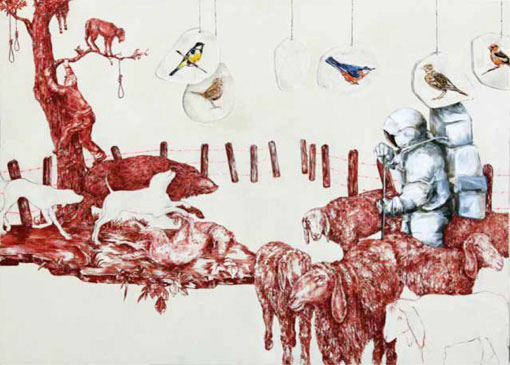
Starting point of the paintings of Karin Brosa are subjects from her surrounding, familiar subjects that she is interested in and occupied with and which she first addresses through drawing in the manner of image qotes and newspaper reports. Within the narrative works nature is often serving as a setting hosting an artificial world. Current affairs are being reflected, highlighted and partly ironically commented, the treatment of animals by humans playing a central role. For instance bear skins serve as a playground for a small boy wearing a fox mask, a surviving bear is watching the scene. Trophies that are usually found in conservative living rooms and inns are re-located to their place of origin, the forest, where they display an aura of misplacement and alienation though. They form a sort of forest themselves now which appears absurd and artificial. A "back to nature" seems impossible.
www.karinbrosa.de
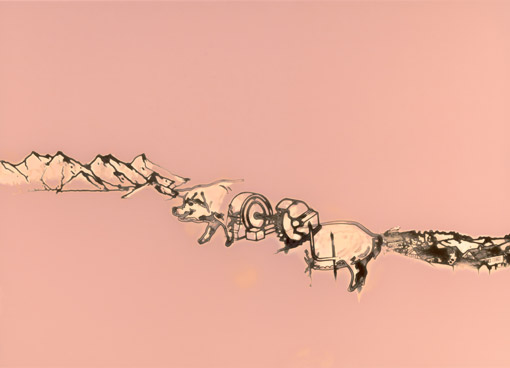
„Now I'm ready to close my eyes. And now I wanna be your dog“ Or your goose. Or your rocket dragonfly. Or butterfly tiger. Everything seems possible in the animal worlds of Yvonne Diefenbach. In those only almost monochrome worlds that attract us by their mysterious, often surreal appearance. Some works appear like antique taxonomic studies, others are abstract compositions of repeating and newly arranged details. The animals seem to be composed in a collage-like manner, as if they cannot exist without the observing look of man. Nevertheless the animals of the artist's imagery are never just objects but with an inherent irony always in control of the situation. The artist works with found or custom-built stamp material and photochemistry directly on paper. This analogue practice causes process inpredictabilities and thus creates authentic originals of only superficial naivete. Her work comes from the field of experimental photography, where she goes without both camera and digital processing and thus relates to the beginnings of artistic photography.
www.yvonne-diefenbach.de
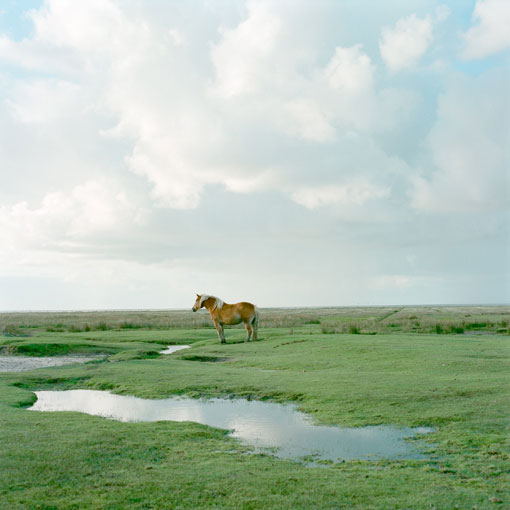
The series shows plowhorses within arcadian sceneries. The square images are mostly divided equally into sky and earth and this juxtaposition is running through many aspects of the work. The depicted animals are present and absent at a time, the close to earth horses appear other-worldly, the flight animals stand eternally. There is no time but some animals are indicative of their age. Solely the fictious bliss seems not to have a counterpart, the fracture fails to appear, the fracture happens in our heads through our search for it, through the knowledge that no further than one kilometre away the world of wonders comes to an end and that it is the viewing angle of the camera that creates this paradise.
www.etta-gerdes.de
The artistic partnership of Afke Golsteijn and Floris Bakker, who collectively are better known as Idiots, presents us with a unique body of work, characterized by the use of animal material exquisitely sculpted into natural positions and combined seamlessly with rich materials such as embroidery and pearls.
A contemporary touch is given to the classical Memento Mori concept, questioning the world’s current trend in over glorification through marketing. In a constantly twisting play between fantasy and reality, Idiots tell us about important themes such as life, death, beauty and restriction.
The striking beauty and the vividness of the animals that figure in the works, conjure powerful emotions of awe and inspiration before giving way to our morbid curiosity surrounding death, which leads us ultimately to think of our own mortality. This contrast between beauty, luxury, and greed coupled with the mystery of death, timelessly preserved, transports one into a transient state of mind, in which anything is possible.
www.idiots.nl
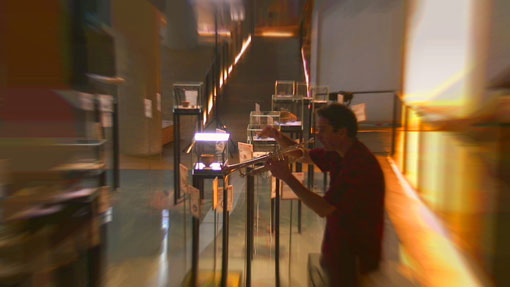
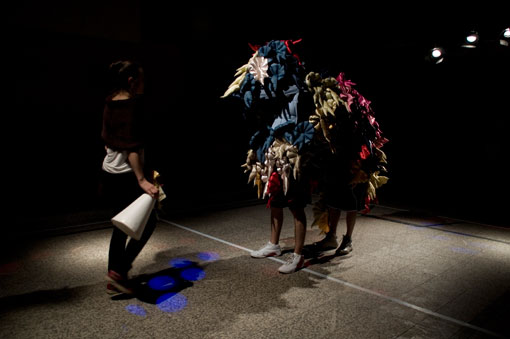
Two friends are hidden underneath the horse-like hull of awardee ribbons. I am training them in figures of the Spanish Riding School as well as dancing steps from disco culture. They are synchronizing their movements, adjusting to each other and loosing their individuality. My task is to support the union and possibly control it. The control is turning into a concern and the beautiful image of a fantastical creature is intertwined with the impertinence of an extreme sport's strain. "First Prize Pony" denotes a state after success when all awards, collected in a fluffy cloud, lead to a state of bemusement and exception.
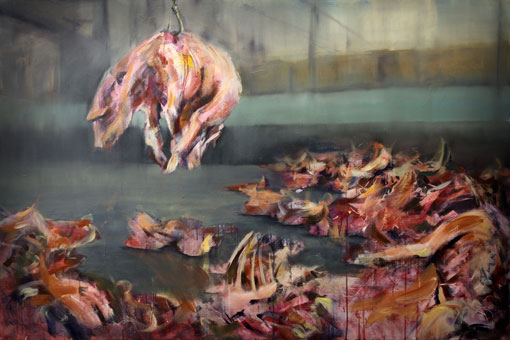
In his paintings Martin Kiewert is critically reflecting the relationship of man with the animal. His meat sceneries remind us of the origin of animal products. Motivated by the longing for a world without hegemony and dominance, neither between humans nor towards animals, Kiewert is drawing from utopian subjects, showing livestock detached from any places of every-day processing. The pig set free does thus not turn into a pet but becomes an individual instead.
www.hartmutkiewert.de
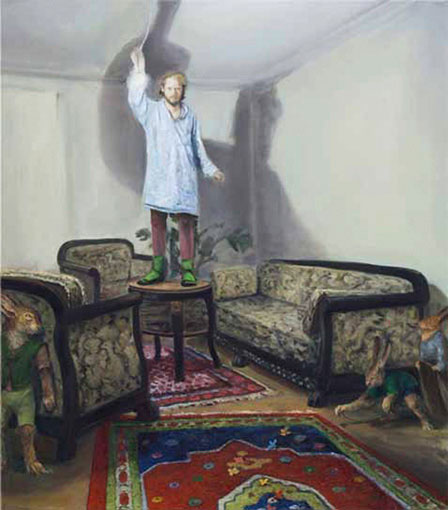
In his paintings Sebastian Meschenmoser is addressing the conflict between man and animal in an appearingly naive, narrative manner. Obviously the scene is about a feud between men and forest animals. The animals seem to rebel and to have started a revolution. Classical situations like attacks, ambuscades, battles or lynching scenes that could originate from Karl May stories are ever re-appearing. The location is not the Wild West or the Orient though but woods and meadows (or interiors) as we know them from works of the German Romantic. People are wearing clothes that cannot be clearly chronologically classified. Colours and technique remind of Wild West paintings by Frederic Remington from the 19th century. The dressed animals make us think of Beatrix Potter's „Peter Rabbit“ or Fritz Koch-Gotha's „Die Häschenschule“. The brutality inhabting the shown scene is covered only at first sight. As early as in medieval times book illustrations by an unknown French monk are showing two rabbits roasting a man over a bonfire. On another we see a rabbit threatening a man with a crossbow. Horror senarios of any missionary were ironically translated into our relationship with nature. The idea that the man-built civilization could ever be re-conquered by nature is equalling apocalypse. Through their monumental imagery Meschenmoser's paintings assert a historical-documentary claim. The absurdity of the shown is however questioning the veracity of the history painting that employs the same imagery.
www.sebastian-meschenmoser.de

The works addresses the field of tension between the instinctive behaviour of animals and the documentary-analytical evaluation by the human spectator. Schidlowski is trying to create a connection between both layers by approaching the intuitive acting of the animal during the origination process of the images. Without any specific guideline the photographer is drawing near to his object, ready to react spontaneously. The results are silent and mystreious images of animal morphologies and landscapes like analytical excerpts that together are tending to form an atmospheric whole. (Elisa Braun, 2009)
www.arno-schidlowski.de
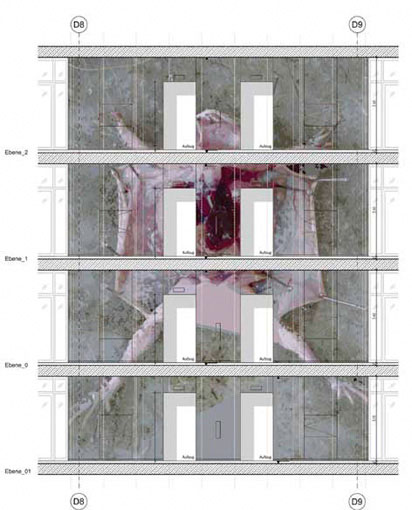
In 2012 Martin G. Schmid participated in the art for architecture competition for a new building of the biology faculty at the University of Regensburg. The participating artists were asked to react content-wise and spatially to the situation on site. Schmid started investigating and found out that the new building was meant to contain animal laboratories. It was inteded to do animal experiments on the brains of mice and rats, prior to which the animals were to be set into states of extreme anxiety. This information had not been given to the artists neither prior to Schmid's discovery nor after his respective prompt to the art on architecture committee. Schmid then submitted a work proposal that explicitly related to animal experiments. As all submissions were to be exhibited this guaranteed the public revelation of the animal experiments and their cover-up.
www.martingschmid.de
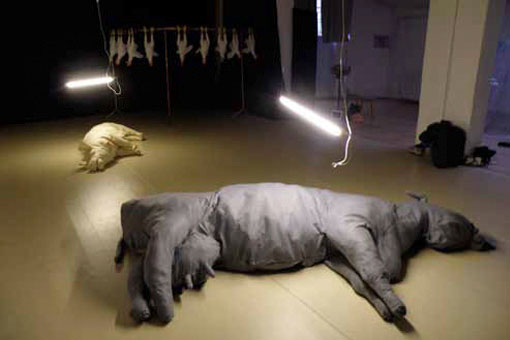
My works depict the exploitation of all kinds of animals, especially of the so-called "livestock". They are met with indifference by many people as they are not confronted with the suffering of the animals that are not pubicly present. My animals reveal this suffering in front of human eyes. In this manner the fact that what we often see on our plates has once been an animal can enter our consciousness. Humans have lost empathy. Through stimulating the lazy brains I want to bring it back so humans can start to acquire the ability of seeing through the system.
www.zambodora.com